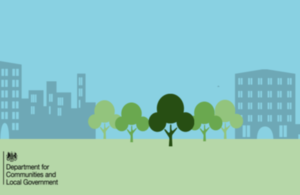Pocket park
The Conservative Party manifesto for the 2015 general election, included a committed to create ‘…an ambitious programme of pocket parks – small areas of inviting public space where people can enjoy relief from the hustle and bustle of city streets”.
This was intended to draw more people outside, give resident more space to relax and to get together with their neighbours, to grow food and provide a safe space for children to play.
A prospectus was published in November 2015, allowing community groups within deprived urban areas to apply for part of a £1.5 million dedicated fund to help them establish pocket parks.
It described pocket parks as ‘…the definition of a pocket park used by the Mayor of London: a piece of land of up to 0.4 hectares (although many are around 0.02 hectares, the size of a tennis court) which may already be under grass but which is unused, undeveloped or derelict.”
Applications from urban areas where there are significantly deprived wards were prioritised in the assessment of bids.
On 15 February 2016, the Department for Communities and Local Government and Communities Secretary Greg Clark MP announced that 87 neglected urban spaces had been selected and would be given help to transform into ‘green oases’. The successful community groups were allocated grants of up to £15,000. Ref https://www.gov.uk/government/news/green-light-given-to-over-80-pocket-parks
Greg Clark, said: “Parks and green spaces breathe life into our bustling towns and cities providing communities with precious spaces to get together, exercise and play. Our funding will benefit urban areas with few green spaces, delivering on the government’s manifesto commitment to deliver pocket parks across our country. These winning bids all have a strong community focus at the core of their plans and their designers have thought up highly creative ideas to turn unloved urban spaces into the green lungs of their communities that will be enjoyed for years to come.”
Graham Duxbury, Groundwork Chief Executive, said: “Every year Groundwork helps hundreds of thousands of people of all ages to organise and work together to protect, preserve, improve or create green spaces on their doorstep. We’re delighted the government is supporting communities and councils to do more. For many local groups, improving the park at the end of their street is the first step in getting much more involved in how their neighbourhood is run.”
[edit] Find out more
[edit] Related articles on Designing Buildings Wiki.
- Areas of outstanding natural beauty.
- Biodiversity in the urban environment.
- Biodiversity offsetting.
- Compact sustainable city.
- Designated sites.
- Ecological network.
- Forests.
- Green belt.
- Green infrastructure.
- National nature reserves.
- National trails.
- National Trust.
- Natural England.
- Protected species.
- Sites of special scientific interest.
- World heritage sites.
- Village green.
Featured articles and news
Government consultations for the summer of 2025
A year of Labour, past and present consultations on the environment, the built environment, training and tax.
CMA competitiveness probe of major housing developers
100 million affordable housing contributions committed with further consultation published.
Homes England supports Greencore Homes
42 new build affordable sustainable homes in Oxfordshire.
Zero carbon social housing: unlocking brownfield potential
Seven ZEDpod strategies for brownfield housing success.
CIOB report; a blueprint for SDGs and the built environment
Pairing the Sustainable Development Goals with projects.
Types, tests, standards and fires relating to external cladding
Brief descriptions with an extensive list of fires for review.
Latest Build UK Building Safety Regime explainer published
Key elements in one short, now updated document.
UKGBC launch the UK Climate Resilience Roadmap
First guidance of its kind on direct climate impacts for the built environment and how it can adapt.
CLC Health, Safety and Wellbeing Strategy 2025
Launched by the Minister for Industry to look at fatalities on site, improving mental health and other issues.
One of the most impressive Victorian architects. Book review.
Common Assessment Standard now with building safety
New CAS update now includes mandatory building safety questions.
RTPI leader to become new CIOB Chief Executive Officer
Dr Victoria Hills MRTPI, FICE to take over after Caroline Gumble’s departure.
Social and affordable housing, a long term plan for delivery
The “Delivering a Decade of Renewal for Social and Affordable Housing” strategy sets out future path.
A change to adoptive architecture
Effects of global weather warming on architectural detailing, material choice and human interaction.
The proposed publicly owned and backed subsidiary of Homes England, to facilitate new homes.
How big is the problem and what can we do to mitigate the effects?
Overheating guidance and tools for building designers
A number of cool guides to help with the heat.
The UK's Modern Industrial Strategy: A 10 year plan
Previous consultation criticism, current key elements and general support with some persisting reservations.
Building Safety Regulator reforms
New roles, new staff and a new fast track service pave the way for a single construction regulator.

























